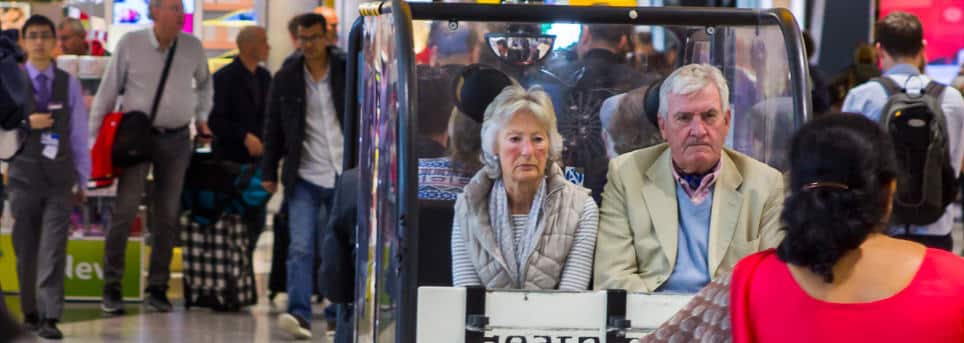PRE COVID-19
The Challenge
The number of Passengers with Reduced Mobility (PRM) has been increasing at London Heathrow Airport (LHR). Given the infrastructure challenges such as the distance between check-in and boarding gates at LHR, electric buggies are used to facilitate PRM movements from International Departures Lounge (IDL) to boarding gates. Whilst PRM service is provided by an airport appointed provider, buggy service is also offered to Premium passengers by other operators who transport premium passengers from IDL to dedicated lounges and to boarding gates.
AiQ was tasked to carry out an ‘Operational Assessment’ of current passenger buggy operations for both; PRM and Premium users to validate the need for increasing the number of buggies. Whilst providing decision making support on increasing the capacity of the buggies, modelling the buggy operations enabled us to report on existing challenges as well as identifying opportunities to optimise the current operation and streamline the user experience.
The Solution
Using our bespoke in-house modelling tool, TransvisionAiR™, backed by on-site surveys studied by our operational experts, we created a base model that was representative of buggy operations and validated with key stakeholders. All surveys were carried out during operational hours to establish process, routings and more importantly challenges faced by front line teams.
Separate models were subsequently created for departures and arrivals as per existing operational practices. Simulation coupled with operational expertise enabled us to report on the bottlenecks within each part of the terminal, what the capacity limits were during the day and where it was breaching acceptable thresholds. High-density areas were identified using the modelling and validated by on-site surveys to inform on measures needed to maintain the safety of all passengers. Identified ‘windows of opportunity’ throughout an operational day where additional buggies could be introduced within the existing terminal layout/ infrastructure for improved passenger experience.
The Benefit
The modelling and on-site surveys provided decision support for increasing buggy capacity within terminal 3. We also provided ‘quick wins’ which focused on not only safety aspects of buggies but effective ways of optimising the operation and therefore leading to better passenger experience. We were able to support our airport buggy modelling work by engaging with wider stakeholders (HAL Fire and Safety Teams) to validate safety aspects of this unique PRM Operation, ensuring our proposed optimisation and efficiency measures did not breach any fire and safety aspects.
- Decision support for operations
- Identification of bottlenecks
- Operational efficiency recommendations
- Identification of 'quick win's for improved passenger experience
- Stakeholder acceptance
- Validation of additional buggies
DURING and POST COVID-19
Resource Optimisation and Staff Efficiency to aid Airports Recovery
Whilst this PRM buggy operation study was carried out before COVID-19, resource utilisation of buggies, wheelchairs, and staff efficiencies are likely to be key concerns when air traffic resumes. According to a study carried out by UK CAA, UK air travel grew 19% between 2010 and 2017 while the number of passengers requiring special assistance grew an incredible 47% (Passenger Terminal World_2018). This is clearly a growing market segment putting resource pressures on airports and rising costs. Whilst countries are rolling out a COVID-19 vaccination programme, passengers requiring special assistance could be one of the first groups of people returning to airports.

